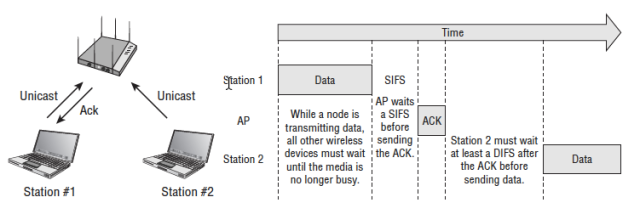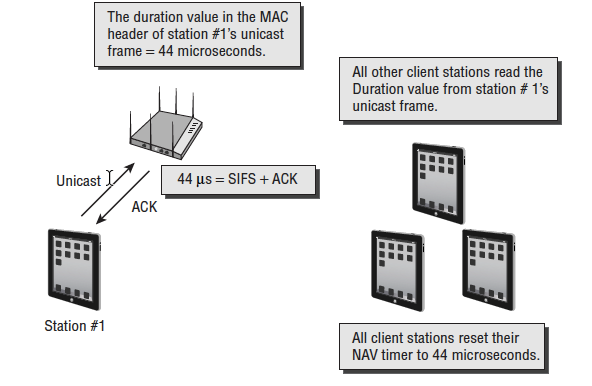My Notes from chapter 8 of the CWNA study guide
Carrier Sense Multiple Access with Collision Avoidance (CSMA/CA) vs. Carrier Sense Multiple Access with Collision Detection (CSMA/CD)
- Set of rules to provide controlled and efficient access to the network medium.
- CSMA/CD is well known and is used by Ethernet networks
- CSMA/CA is not as well known and is used by 802.11 networks
- The difference between CSMA/CD and CSMA/CA exists at the point when a client wants to transmit and no other clients are presently transmitting
- CSMA/CD
- Nodes can immediately start transmitting, if a collision is detected then they temporary stop transmitting
- CSMA/CA
- 802.11 wireless radios are not capable of transmitting and receiving at the same time, so they are not capable of detecting a collision during their transmission – therefore they use CSMA/CA
- Station has determined that no other stations are transmitting, the 802.11 radio will choose a random backoff value
- Carrier sense determines whether the medium is busy
- Multiple access ensures that every radio gets a fair shot at the medium (but only one at a time)
- Collision avoidance means only one radio gets access to the medium at any given time, hopefully avoiding collision
- Collision detection
- Every time an 802.11 radio transmits a unicast frame, if the frame is received properly, the 802.11 radio that received the frame will reply with an acknowledgment (ACK) frame.
- The ACK frame is a method of delivery verification of unicast frames
- 802.11n and 802.11ac radios make use of frame aggregation – block ACK
- Broadcast and multicast frames do not require an acknowledgment
- If any portion of a unicast frame is corrupted, the cyclic redundancy check (CRC) will fail and the receiving 802.11 radio will not send an ACK frame
- if an ACK frame is not received by the original radio, there is collision assumption

Distributed Coordination Function (DCF)
- Interframe space (IFS)
- Is a period of time that exists between transmissions of wireless frames
- Three Types
- Reduced interframe space (RIFS), highest priority
- Short interframe space (SIFS), second highest priority
- PCF interframe space (PIFS), middle priority
- DCF interframe space (DIFS), lowest priority
- Arbitration interframe space (AIFS), used by QoS stations
- Extended interframe space (EIFS), used after receipt of corrupted frames
- Interframe spaces are all about what type of 802.11 traffic is allowed next

- Duration/ID field
- One of the fields in the MAC header of an 802.11 frame
- Duration/ID value represents the time, in microseconds, that is required to transmit an active frame exchange process so that other radios do not interrupt the process
- the value of the Duration/ID field indicates how long the RF medium will be busy before another station can contend for the medium
- Virtual Carrier sense
- Uses a timer mechanism known as the network allocation vector (NAV)
- The NAV timer maintains a prediction of future traffic on the medium based on Duration value information seen in a previous frame transmission

- Physical Carrier Sense
- Mechanism to determine if the medium is busy
- Performed constantly by all stations that are not transmitting or receiving
- It is actually listening to the channel to see whether any other transmitters are taking up the channel
- Physical carrier sense has two purposes:
- The first purpose is to determine whether a frame transmission is inbound for a station to receive. If the medium is busy, the radio will attempt to synchronize with the transmission
- The second purpose is to determine whether the medium is busy before transmitting. This is known as the clear channel assessment (CCA). The CCA involves listening for RF transmissions at the Physical layer. The medium must be clear before a station can transmit.
- Random backoff timer
- 802.11 station may contend for the medium during a window of time known as the backoff time
- The station chooses a random number from a range called a contention window (CW) value. After the random number is chosen, the number is multiplied by the slot time value.
- When the backoff time is equal to 0, the client can reassess the channel and, if it is clear, begin transmitting.
Point Coordination Function (PCF)
- Optional medium access
- This access method is a form of polling.
- AP performs the function of the point coordinator (PC)
- PCF medium access method will work in only a basic service set (BSS)
- Because polling is performed from a central device, PCF provides managed access to the medium.
- Both the AP and the station must support it
Hybrid Coordination Function (HCF)
- HCF defines the ability for an 802.11 radio to send multiple frames when transmitting on the RF medium
- When an HCF-compliant radio contends for the medium, it receives an allotted amount of time to send frames. This period of time is called a transmit opportunity (TXOP)
- 802.11 radio may send multiple frames in what is called a frame burst. A short Interframe space (SIFS) is used between each frame to ensure that no other radios transmit during the frame burst.
- Enhanced Distributed Channel Access (EDCA)
- Wireless media access method that provides differentiated access that directs traffic to four access-category QoS priority queues.
- EDCA defines four access categories
- AC_BK (Background)
- AC_BE (Best Effort)
- AC_VI (Video)
- AC_VO (Voice)
- HCF Controlled Channel Access (HCCA)
- Is a wireless media access method that uses a QoS-aware centralized coordinator known as a hybrid coordinator (HC)
Block acknowledgment (BA)
- Defined in the 802.11-2012 standard
- Improves channel efficiency by aggregating several acknowledgments into one single acknowledgment frame
- Two Types:
- The immediate Block ACK is designed for use with low-latency traffic
- The delayed Block ACK is more suitable for latency-tolerant traffic

Wi-Fi Multimedia (WMM)
- Prior to 802.11e amendment, no adequate QoS procedures had been defined for the use of time-sensitive applications
- The Wi-Fi Alliance introduced the Wi-Fi Multimedia (WMM) certification as a partial mirror of 802.11e amendment
Airtime Fairness


Great work!!
I’m behind of you for 6 chapters but, they’re really helping me a lot.
thanks for share.
LikeLike
Hi Daniel,
Glad they are helping out.
Hopefully my work settles down and I can finish compiling the rest of the chapters and upload them to the site.
I have just finished reading the self study guide and purchased the official practice exams so hoping to sit the exam in the next few weeks.
Compiling the notes is really helping refresh the earlier chapters for me.
LikeLike
Thanks for your notes.
I wish you the best!!
LikeLike
this is awesome!! are the previous chapters available at all? 1-7
LikeLike
Yes they are. Search CWNA in the search box
LikeLike